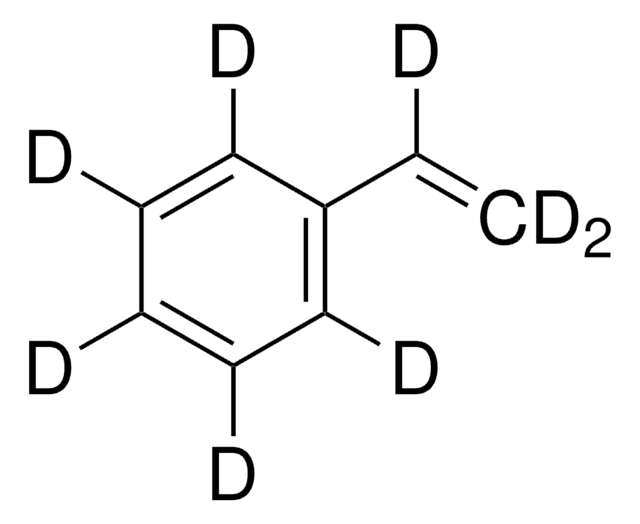Key Documents
47745-U
Styrene
analytical standard
Synonim(y):
Phenylethylene, Vinylbenzene
About This Item
Polecane produkty
klasa czystości
analytical standard
Poziom jakości
gęstość pary
3.6 (vs air)
ciśnienie pary
12.4 mmHg ( 37.7 °C)
4.3 mmHg ( 15 °C)
Certyfikat analizy
current certificate can be downloaded
temp. samozapłonu
914 °F
granice wybuchowości
6.1 %
opakowanie
ampule of 1000 mg
metody
HPLC: suitable
gas chromatography (GC): suitable
współczynnik refrakcji
n20/D 1.546 (lit.)
tw
145-146 °C (lit.)
mp
−31 °C (lit.)
gęstość
0.906 g/mL at 25 °C
Zastosowanie
environmental
format
neat
temp. przechowywania
2-8°C
ciąg SMILES
C=Cc1ccccc1
InChI
1S/C8H8/c1-2-8-6-4-3-5-7-8/h2-7H,1H2
Klucz InChI
PPBRXRYQALVLMV-UHFFFAOYSA-N
Szukasz podobnych produktów? Odwiedź Przewodnik dotyczący porównywania produktów
Opis ogólny
Zastosowanie
Inne uwagi
Hasło ostrzegawcze
Danger
Zwroty wskazujące rodzaj zagrożenia
Zwroty wskazujące środki ostrożności
Klasyfikacja zagrożeń
Acute Tox. 4 Inhalation - Aquatic Chronic 3 - Asp. Tox. 1 - Eye Irrit. 2 - Flam. Liq. 3 - Repr. 2 - Skin Irrit. 2 - STOT RE 1 Inhalation - STOT SE 3
Organy docelowe
hearing organs, Respiratory system
Kod klasy składowania
3 - Flammable liquids
Klasa zagrożenia wodnego (WGK)
WGK 2
Temperatura zapłonu (°F)
89.6 °F - closed cup
Temperatura zapłonu (°C)
32.0 °C - closed cup
Środki ochrony indywidualnej
Eyeshields, Faceshields, Gloves, type ABEK (EN14387) respirator filter
Wybierz jedną z najnowszych wersji:
Masz już ten produkt?
Dokumenty związane z niedawno zakupionymi produktami zostały zamieszczone w Bibliotece dokumentów.
Protokoły
GC Analysis of Xylene Isomers on SLB®-IL60
US EPA Method TO-17: GC Analysis of Volatiles on VOCOL® after Collection/Desorption using Air Toxics Tube
US EPA Method 8260: GC Analysis of Volatiles on SPB®-624 after Purge & Trap using "K" Trap, Fast GC Analysis
Nasz zespół naukowców ma doświadczenie we wszystkich obszarach badań, w tym w naukach przyrodniczych, materiałoznawstwie, syntezie chemicznej, chromatografii, analityce i wielu innych dziedzinach.
Skontaktuj się z zespołem ds. pomocy technicznej









